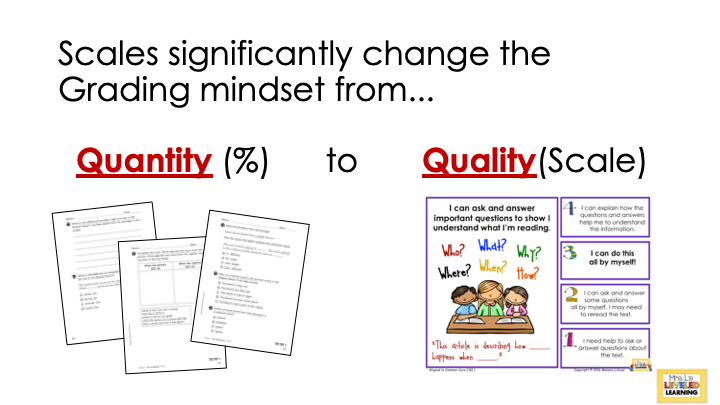Confused by Grading Proficiency Scales?
Grading with proficiency scales doesn’t have to be confusing, if you know what each level MEANS.
Many school districts have switched to using proficiency scales for grading. Proficiency Scales became mandatory in many school districts after some research published in 2009 by Marzano and Hasted. They found that among the variety of teaching strategies that help students succeed, tracking student progress by scoring scales was the most effective! Since then schools have been figuring out how to align scales to the traditional grading model. If your school advocates a growth mindset, standards based grading, or the Marzano framework, this post is for you.
Scales are just a way to break your learning goal into easier steps for students. Everybody knows what learning goals are, but usually students never see them. So when you create a scale, you are showing students what they’re learning and you are helping them connect prior knowledge to the current expectations, maybe even above. It provides a path of learning. After a few examples, you and your students will know how to interpret the levels of a scale to indicate progress.
What Do the Levels Mean?
1. Level one is going to be for students who are very on the low end of the learning or performance spectrum. They may have special needs or require special learning modifications. These students typically start below their grade-level peers and need a lot of concrete support to understand concepts.
2. Level two is where most of your students my fall. They have some knowledge from the previous grade level. You know what they come in having been exposed to. While they might not have mastered the content from previous grade levels, you know for sure they’ve seen it before. This is a great starting place to assess their previous knowledge when you introduce a new topic.
3. Level three is the grade level standard.* I always like to change the wording of the standard into kid-friendly language that students are going to understand. Number three is always going to be the learning goal for your students at grade level. This is the exact content and skills that they need to master before end-of-year testing.
4. Level four is not required for all students to master. It depends what your district expectations are. Usually your gifted and high ability students might be working at level four or will be required to advance to level four. This is a higher application of grade level skills. Your students might be asked to use the grade level content indifferent ways. You could go in greater depth or in greater breadth. But basically level four is advanced use of related content of the same learning goal.
As you read each level in order, there should be a clear and simple progression of skills and concepts that are going to help your students understand what proficiency looks like. All your students come in at different places. So it’s kind of helpful to have a quick reference for the different levels of proficiency.
How Does Grading Change when I Use a Scale?
Once you start using scales in your classroom, you’ll notice they significantly change your grading mindset. Traditional grading is based on QUANTITY. You give a test with a bunch of different skills, and then you grade the percentage correct. The image above shows a language arts test for second graders. You’re going to have questions about vocabulary, comprehension, maybe the story structure, and answering questions. A lot of different skills are usually mixed into these traditional tests and students get a grade based on the quantity they get right. When working with a scale you’re going to look for the quality of understanding, focused around one learning goal at a time. (Honestly, I have clustered a few related learning goals together for the sake of expediency, but they were still narrowly focused.)
The scale above shows that a student at level three would be totally proficient at doing this themselves and they’d be able to ask questions that are pertinent to understanding the story. A level two proficiency would be, “I can ask and answer some questions by myself.” They might need to reread to find answers or their questions might not be totally relevant. Students performing at level two will have a lower quality of proficiency with this scale. Level one, they’re your kids that need a lot of extra support. And level four, these are your kids who could probably teach the class how to do this. They would have an in-depth understanding of the text and maybe even be able to analyze what questions are the best to address a specific purpose. Each level of your scale shows a different quality of understanding. This usually gets translated into percentages, which is where many teachers have different interpretations. Grading consistently between classrooms is a concern for some administrators.
This 9 minute video will give you an in-depth walk through the MEANING of each level of a proficiency scale, and how to align each level to a percentage.

